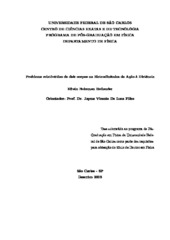Problema relativístico de dois corpos.
Abstract
We study the relativistic two-body problem of the action-at-a-distance electrodynamics.
This dynamical system appeared 100 years ago as a time-symmetric relativistic
motion and acquired the status of electrodynamics in the 1940 s by the works of Dirac,
Wheeler and Feynman. The equations of motion for this problem are delay equations
involving retarded and advanced arguments symmetrically. We outline our dynamical
studies with an emphasis on the physics of this complex conservative dynamical system.
We study the following versions of this electromagnetic two-body problem:
(i) For the case of two arbitrary masses with attractive interaction (hydrogen atom),
we develop a numerical method to integrate the three-dimensional motion. This method
has a very limited applicability and could not answer several dynamical questions. We
calculated numerically some orbits. The difficulties of this complex case suggested that
we should restrict the study to the simpler problem of straight-line orbits and equal
masses ( (ii) and (iii) ).
(ii) We study the colinear orbits of the repulsive problem of two electrons (two electrons
moving on the same line). We obtain an analytical approximation for the low-energy
colinear orbits. We also develop a stable numerical method based on steepest-descent
minimization. Using this method we calculated the orbits numerically for several energies.
We also found a two-degree-of-freedom implicit Hamiltonian formalism to describe
this colinear motion.
(iii) For the attractive problem with equal masses, we derive an equation of motion
that is regular at the collision. Our method uses the energy constant related to the
Poincaré invariance of the theory to motivate the regularizing coordinate transformation
and to remove infinities from the equation of motion. The collision orbits are calculated
numerically using the regular equation adapted in a self-consistent minimization method
(a stable numerical method that chooses only nonrunaway orbits). We compare our
regularization of this Poincaré-invariant case to the Levi-Civita regularization of the
Galilei-invariant Kepler problem.
